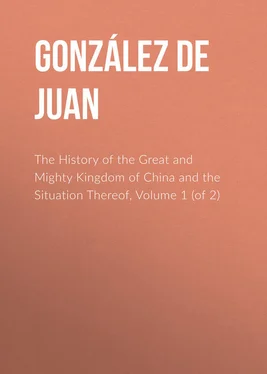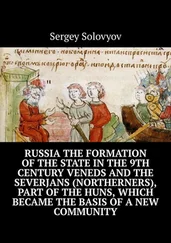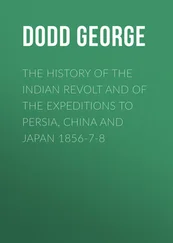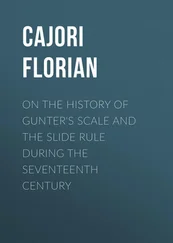Juan González de Mendoza - The History of the Great and Mighty Kingdom of China and the Situation Thereof, Volume 1 (of 2)
Здесь есть возможность читать онлайн «Juan González de Mendoza - The History of the Great and Mighty Kingdom of China and the Situation Thereof, Volume 1 (of 2)» — ознакомительный отрывок электронной книги совершенно бесплатно, а после прочтения отрывка купить полную версию. В некоторых случаях можно слушать аудио, скачать через торрент в формате fb2 и присутствует краткое содержание. Жанр: foreign_antique, foreign_prose, Путешествия и география, на английском языке. Описание произведения, (предисловие) а так же отзывы посетителей доступны на портале библиотеки ЛибКат.
- Название:The History of the Great and Mighty Kingdom of China and the Situation Thereof, Volume 1 (of 2)
- Автор:
- Жанр:
- Год:неизвестен
- ISBN:нет данных
- Рейтинг книги:4 / 5. Голосов: 1
-
Избранное:Добавить в избранное
- Отзывы:
-
Ваша оценка:
- 80
- 1
- 2
- 3
- 4
- 5
The History of the Great and Mighty Kingdom of China and the Situation Thereof, Volume 1 (of 2): краткое содержание, описание и аннотация
Предлагаем к чтению аннотацию, описание, краткое содержание или предисловие (зависит от того, что написал сам автор книги «The History of the Great and Mighty Kingdom of China and the Situation Thereof, Volume 1 (of 2)»). Если вы не нашли необходимую информацию о книге — напишите в комментариях, мы постараемся отыскать её.
The History of the Great and Mighty Kingdom of China and the Situation Thereof, Volume 1 (of 2) — читать онлайн ознакомительный отрывок
Ниже представлен текст книги, разбитый по страницам. Система сохранения места последней прочитанной страницы, позволяет с удобством читать онлайн бесплатно книгу «The History of the Great and Mighty Kingdom of China and the Situation Thereof, Volume 1 (of 2)», без необходимости каждый раз заново искать на чём Вы остановились. Поставьте закладку, и сможете в любой момент перейти на страницу, на которой закончили чтение.
Интервал:
Закладка:
The most interesting portion of his narrative is unquestionably that which refers to China, of which he speaks under the names of Kataia and Manji; the former, as we have already stated, denoting the northern, and the latter the southern part of the empire. The northern kingdom of Kataia contained the residence of Kublai Khan, while the south, although subjugated, had not been completely incorporated into the almost boundless Tartar dominion, which had been established by Kublai's victorious ancestor, the renowned Zenghis Khan.
The route by which Polo entered China was along the northern frontier, and is thus referred to by Mr. Marsden: – "Having reached the borders of Northern China, and spoken of two places (Succuir, the modern Sucheu, and Kampion, the modern Kancheu) that are within what is named the Great Wall, our author ceases to pursue a direct route, and proceeds to the account of places lying to the north and south, some of them in the vicinity and others in distant parts of Tartary, according to the information he had acquired of them on various occasions. Nor does he in the sequel furnish any distinct idea of the line he took upon entering China, in company with his father and uncle, on their journey to the emperor's court, although there is reason to believe that he went from Kan-cheu to Sining, and there fell into the great road from Thibet to Peking." Before reaching the latter city, however, they visited Karakorum, already referred to as the capital of the Khan's dominions visited by Rubruquis. This city, Mr. Marsden says, was built by Oktar Khan, the son and successor of Jenghis Khan, about the year 1235, whose nephew Mangu Khan, made it his principal residence. No traces of it have been in existence for some centuries, but its position is noted in the Jesuits' and Danville's maps. J. Reinhold Forster, however, on the authority of Fischer's History of Siberia , observes, that it must be looked for on the east side of the river Orchon, and not on the Onghin or Onguimuren, where D'Anville has placed it.
From the length of time which had elapsed since Nicolo and Maffeo Polo had left China as Kublai's ambassadors, they were forgotten, but as soon as the Khan, who was then absent, heard of their arrival at Karakorum, he issued orders that they should be received with all honour and escorted to his presence. The appearance of young Marco produced a highly favourable impression upon the Khan, who immediately took him under his especial protection. The assiduity of Marco in studying the language and manners of the Tartars, and the wisdom and prudence which he exhibited in the exercise of the various important functions in which he was employed by the Khan, caused him rapidly to rise in the estimation and favour of that liberal-minded monarch. Upon the removal of the Khan to Khambalu, a corruption of Khambalig (capital of the Khan), and understood to be the modern Pekin, Marco followed in his train. This city was found to surpass in splendour everything that he had yet met with. The dimensions of the palace comprehended a square, each side of which was six miles long, a statement not very widely different from the truth. This enclosure, however, comprised all the royal armouries, as well as fields and meadows, stored with various descriptions of game. The roofs of the spacious halls were covered with gorgeous gilding, and painting in brilliant colours, while representations of dragons and battles were carved upon the sides. To the north of the palace stood an eminence called the Green Mountain, of about a mile in circuit, covered with the finest trees which could be collected from all parts of the empire, and which had been brought by elephants to this spot.
This account strikingly agrees with those of modern travellers, and the description of the internal government of the country, its postal arrangements, and the beneficent distribution of grain from the imperial granaries in times of scarcity, agree with since recognized Chinese history.
Marco subsequently made an excursion into the country of Manji, or Southern China, his route lying by the course of the imperial canal. In his southward progress, after passing by various cities, he at length reached Tinqui (Taitcheou), distant about three days' journey from the sea, where there is an extensive manufactory of salt, an article which forms a leading article of commerce in China. He next came to Yanqui (Yangtcheoufou), at the mouth of the river Yang-tsi-kiang, the seat of a viceroy, in which Polo himself exercised for the space of three years the supreme jurisdiction. His subsequent route lay along the banks of the Yang-tsi-kiang, and he incidentally alludes to the noble city of Nanghin (Nanking), where he speaks of the manufacture of cloths of gold and silver, but does not seem to have visited the city itself. Taking thence a southward course, he reached Quinsai (Hang-cheou), or the city of heaven, the splendour of which still important place was at that time such, that he speaks of it in the following terms: "In the world there is not the like, nor a place in which there are found so many pleasures, that a man would imagine himself in paradise." This city, then the metropolis of Manji, was in the height of its glory, and may well be supposed to have surpassed in grandeur any city which Polo had seen; and if he is to be charged with exaggeration in describing it as one hundred miles in circumference, and to have contained one million six hundred thousand houses, and twelve thousand bridges, it must be remembered that its really immense extent was calculated to mislead the judgment of an observer, and to make him credulous of the accounts of the inhabitants. It is still a splendid and very extensive city, and it is not to be wondered at that Polo, who witnessed its unfaded glories, should have dwelt with enthusiasm on its spacious and beautiful palaces, and its waters covered with richly decorated barges. The character of the inhabitants he describes as effeminate, luxurious, and unwarlike.
In his southward journey Polo mentions many great cities in Manji, which it would be difficult to identify with their modern nomenclature. Among these Unguen, a city of the province of Fokien, is referred to, as remarkable for its extensive manufacture of sugar, sent from thence to Khambalu; its natives being described as skilled in the art of refining it with wood ashes, from persons belonging to Babylonia (Egypt). It is also worthy of notice, that his embarcation took place at a famous port called Zaitun, which was much frequented by ships with rich cargoes from India for the supply of Manji and Kataia, and exceedingly productive in revenue to the grand Khan, who received ten per cent. on all merchandise. In spite of this impost, and the heavy freights, amounting to nearly fifty per cent., the merchants are described as making enormous profits.
The inhabitants of the place are represented as distinguished for their skill in embroidery and tapestry. This has been supposed to mean Fou-cheou-fu, Amoy, or some neighbouring port in Fokien; but it is difficult to reconcile this with the statement that one arm of the river on which this city stood reached to Quinsay, which, as we have already stated, appears to be intended for the great city of Hang-cheou.
The next in rotation on our list of eastern travellers, is Giovanni di Monte Corvino, a Franciscan monk of Calabria, who went as ambassador from Pope Nicholas IV in 1288 to the grand Khan, and died in Khambalu, that is, Pekin, holding the distinguished position of archbishop of the missions in that city. His letters refer to little more than the progress he made in the advancement of the Roman Catholic religion in that capital.
The next traveller in China of whom we have to speak is Oderico Mattheussi, a Minorite friar, more commonly known under the name of Oderico de Pordenone, from Pordenone in Friuli, in which place he was born about the year 1285. He undertook a journey in 1317, accompanied by several other monks, through Tartary, by Trebizond, to China, and returned by Thibet to Europe. In 1330, a year before his death, he dictated in Padua, to Guglielmo di Solagno, a monk, an account of his travels as they occurred to his memory, in the Italian language. An English translation is given by Hakluyt in his second volume, from which we quote the following extracts.
Читать дальшеИнтервал:
Закладка:
Похожие книги на «The History of the Great and Mighty Kingdom of China and the Situation Thereof, Volume 1 (of 2)»
Представляем Вашему вниманию похожие книги на «The History of the Great and Mighty Kingdom of China and the Situation Thereof, Volume 1 (of 2)» списком для выбора. Мы отобрали схожую по названию и смыслу литературу в надежде предоставить читателям больше вариантов отыскать новые, интересные, ещё непрочитанные произведения.
Обсуждение, отзывы о книге «The History of the Great and Mighty Kingdom of China and the Situation Thereof, Volume 1 (of 2)» и просто собственные мнения читателей. Оставьте ваши комментарии, напишите, что Вы думаете о произведении, его смысле или главных героях. Укажите что конкретно понравилось, а что нет, и почему Вы так считаете.












